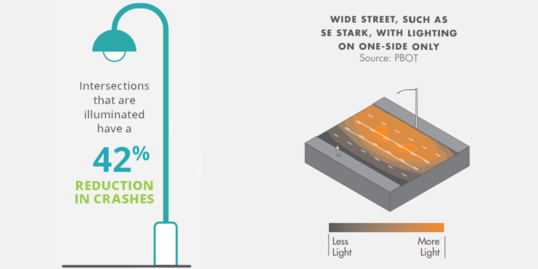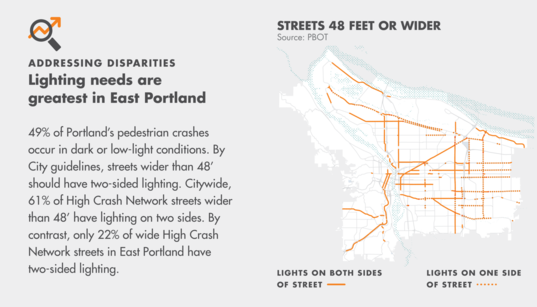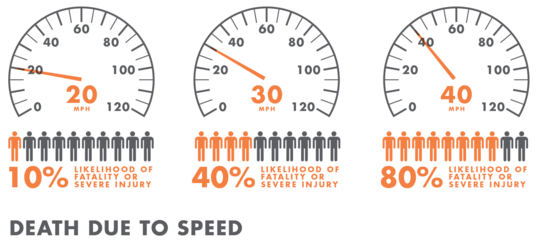|
(Oct. 28, 2019) As we head into the darker months of the year, we want to shine a light on the surprisingly complicated topic of roadway illumination.
We know that streetlights make travel safer. For example, adding lighting at intersections can reduce crashes by as much as 42 percent. We also know that many parts of Portland lack adequate streetlighting, particularly east of Interstate 205 (more on that below).
So why not just crank up the streetlights we already have?
It turns out that streetlighting isn’t that simple, and that increased brightness can even make things worse.
What ‘adequate lighting’ means
The quality or “level” of lighting refers to both brightness and uniformity.
Without getting into the technical details, Portland’s highest level of lighting should illuminate the full width of a street, including space used by pedestrians and people biking. It should also avoid sharp variations in brightness that can strain eyes and impair visibility (akin to sudden bright lights in a dark room).
 Lighting is particularly valuable at intersections (left graphic) and should be two-sided on wide streets (right graphic). (Click for larger image.)
Adequate lighting depends on the street. Streets meant for local use, rather than longer distance thru-trips, have the lowest level of lighting. Lighting levels scale up to their highest point on our “major” streets. (You can view a map of these streets at this link and selecting “TSP Traffic Classifications” from the layer list.)
Our guidelines also call for higher lighting levels at intersections and mid-block crossings.
The importance of lighting uniformity—not just brightness—is one reason we can’t simply tweak existing street lights to achieve appropriate illumination. In addition to the potentially negative effects on traffic safety, increased brightness can spill over onto private property, waste energy, and damage the natural environment.
Recent evaluation pinpoints lighting opportunities
In 2018 we analyzed the streetlighting on Portland streets with the most deadly crashes. These streets receive priority for safety investments as part of Portland’s Vision Zero work to eliminate traffic deaths and serious injuries.
Among the evaluation’s findings: Some of our highest-crash streets would benefit from having lighting on both sides of the street (see map below). Two-sided lighting is necessary for adequate illumination uniformity—resulting in fewer bright and dark spots—that would help people see each other.
 Lighting conditions are especially deficient east of Interstate 205. (Click for larger image.)
As a result of this evaluation, we are working to get two-sided lighting where it is needed. Since this usually requires putting new poles into the street, we must coordinate this work with local utilities to avoid overhead space conflicts. We also must ensure that new poles don’t block the path of pedestrians.
While we work on a plan for two-sided lighting, we are moving forward with measures that include adding more midblock crossings with lighting and identifying places we can enhance lighting by adding fixtures to existing poles.
You can find more information about our lighting commitments and actions in Strategy 6 of our PedPDX Pedestrian Master Plan and our Vision Zero 2-Year Update.
Dark outside? Please take it slow
While we work to improve streetlighting, please do your best to drive more slowly in dark conditions. Even small changes in speed can dramatically improve safety (see graphic).
 Crashes become sharply more deadly at higher speeds, especially for collisions involving pedestrians.
A recent study concluded that many of us do not sufficiently adjust our travel speed as visibility changes, and concluded that “the risk of accidents associated with darkness or road lighting can be explained by this lack of speed adjustment.”
Thank you for doing what you can to keep yourself and others safe this fall and winter.
To learn more about efforts by the City of Portland and regional partners to eliminate traffic fatalities and serious injuries, see PBOT's Vision Zero website
Email: visionzero@portlandoregon.gov
|